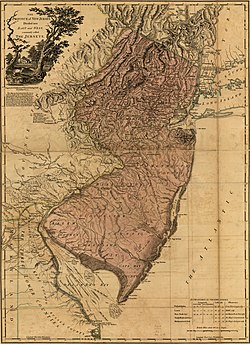New Jersey | |||||||||||||||||
|---|---|---|---|---|---|---|---|---|---|---|---|---|---|---|---|---|---|
| 1664–1673 1702–1776 | |||||||||||||||||
 The Province of New Jersey, Divided into East and West, commonly called The Jerseys, 1777 map by William Faden | |||||||||||||||||
| Status | Proprietary Colony of England (1664–1673) Royal Colony of England (1702–1707) Royal Colony of Great Britain (1707–1776) | ||||||||||||||||
| Capital | Elizabethtown (1664–1673) Perth Amboy and Burlington (1702–1776) | ||||||||||||||||
| Common languages | English, Dutch | ||||||||||||||||
| Religion | Church of England (Official) | ||||||||||||||||
| Government | Proprietary colony (1664-1673) Royal colony (1702-1776) | ||||||||||||||||
| Lords Proprietors | |||||||||||||||||
• 1664-1673 | Lord Berkeley of Stratton Sir George Carteret | ||||||||||||||||
| Governor | |||||||||||||||||
• 1664-1665 | Richard Nicolls (first) | ||||||||||||||||
• 1672-1673 | John Berry (last) | ||||||||||||||||
| Royal Governor | |||||||||||||||||
• 1702-1708 | Lord Cornbury (first) | ||||||||||||||||
• 1763-1776 | William Franklin (last) | ||||||||||||||||
| Legislature | Council General Assembly Provincial Congress (1775-1776) | ||||||||||||||||
| History | |||||||||||||||||
• 1609 | 1664 | ||||||||||||||||
• 1666 | 1776 | ||||||||||||||||
| Currency | New Jersey pound | ||||||||||||||||
| |||||||||||||||||
| Today part of | United States | ||||||||||||||||
| History of New Jersey |
|---|
 |
| Colonial period |
| American Revolution |
| Nineteenth century |
| Twentieth century |
| Twenty-first century |
The Province of New Jersey was one of the Middle Colonies of Colonial America and became the U.S. state of New Jersey in 1776. The province had originally been settled by Europeans as part of New Netherland but came under English rule after the surrender of Fort Amsterdam in 1664, becoming a proprietary colony. The English renamed the province after the island of Jersey in the English Channel. The Dutch Republic reasserted control for a brief period in 1673–1674. After that it consisted of two political divisions, East Jersey and West Jersey, until they were united as a royal colony in 1702. The original boundaries of the province were slightly larger than the current state, extending into a part of the present state of New York, until the border was finalized in 1773.[1]
- ^ The New York – New Jersey Line War (also known as the "N.J. Line War") refers to a series of skirmishes and raids that took place between 1701 and 1765 at the disputed border between two American colonies — the Province of New Jersey and the Province of New York.
